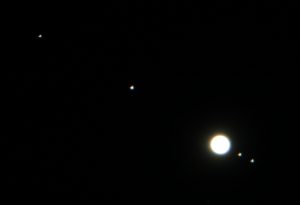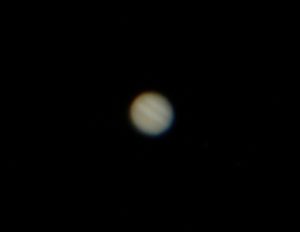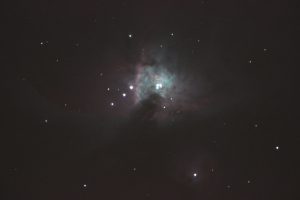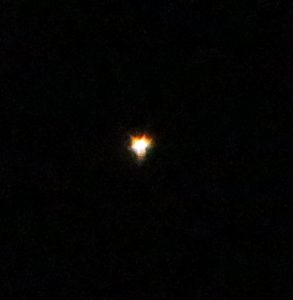I awoke to the buzzing of my wristwatch. It was 4:30am. The telescope and all its accessories were already in the car. I only needed to get out of bed and dress myself. Jupiter waited. In the night sky above Allen, I was sure it was clear and that Jupiter waited. So I put on warm clothes, a hat, and a scarf. I put coffee in a thermos. I hit the road for a nearby hill.
Jupiter waited. But so did something far more extraordinary.
Jupiter

Indeed, there was Jupiter. As I setup the telescope, I could see it bright and big and well above the horizon. It was 5am now. A quick calibration and I was able to direct the scope to point itself at the great gas giant, protector of the Solar System. The view was spectacular. I’m still getting the hang of photographing using the DSLR camera that mounts on the scope, but you get the idea. The great gas giant is surrounded by the four most visible moons – the Galilean Moons: Io, Europa, Ganymede, and Callisto. In order, from inner-most to outer-most, they appear in the list I just mentioned.

Decreasing the exposure time and lowering the ISO allowed for a much clearer view of the planet itself. The upper atmosphere of Jupiter contains ammonia ices; this gives it the creamier white colors. Where those clouds clear, we see below into the reds and oranges of its lower, Hydrogen-rich atmosphere. These zones of clouds form bands that encircle the planet. That banding is much more visible in this second exposure at high shutter-speed with low ISO.
After spending some time looking at and photographing Jupiter, I decided to turn my attention to one of my favorite constellations: Orion. I decided to do a tour of the major stars and features of this prominent structure in the night sky.
The Orion Nebula
At first, I looked at Rigel, the bright blue star that forms the western-most foot of the hunter. I took some shots of it and then started to tour around the other features. Then it dawned on me: shouldn’t the Orion Nebula be visible to a telescope this size. I sent the scope to the nebula, and when I looked through the eyepiece, I started to cry a little.
Never in my life had I seen something so big and beautiful. The nebula appears to the eye through the scope as a bluish cloud with bright central stars lighting up the gas of the structure. Even on low magnification, this structure was highly visible to the eye. I grabbed the camera and swapped it for the eyepiece. I started playing with exposure time and ISO. My two favorite photographs are below.


The first photograph shows the rich color and structure of the Nebula, with big swooping arms of hot gas stretching out for immense distances in every direction. The second photograph highlights the cloud of dust that obscures the lower part of the Nebula.
I had to tape my jaw closed. Every time I took a photo, a stream of exclamatory statements – some I won’t repeat – came out in whispers in the morning air. Jodi arrived on the scene just as I finished this viewing of the Nebula. I showed her pictures, and I put the eyepiece back in so she could see how it appeared to the eye instead of how it appears to the camera.
As the sun began to rise, we turned our attention to those stars in Orion again: Betelgeuse and Rigel.
Betelgeuse and Rigel

Betelgeuse and Rigel are example stars you use in introductory Astronomy to talk about stars off the Main Sequence. Betelgeuse, the 2nd-brightest star in Orion, is a spectral class M red supergiant. Our star is a K-class star, yellowiosh in appearance as its mid-spectrum in temperature. Betelgeuse is a big, red monster. Were it to be located in our Solar System, it would engulf the asteroid belt given is bloated size. Betelgeuse is in the process of dying. It’s in the last 10% of its life. It will likely explode as a core-collapse supernova in the next million years. It will be spectacular.

Rigel is at the opposite end of the spectrum, and is the brightest in Orion. Rigel is a triple star system composed of an A-class blue-white supergiant, and a B-class companion. Rigel A is also in the process of dying, and is bloated out to about 100 times the radius of our own Sun. It, too, will end spectacularly as a supernova. It is about 860 light-years from Earth, and is one of the closest stars that is expected to die as a core-collapse supernova. A-class stars live fast and die young. Rigel should blow relatively soon, within thousands of years.
This was an incredible Sunday morning. My nieces and nephews arrive this week for Thanksgiving. I cannot wait to show them the universe through this telescope.

